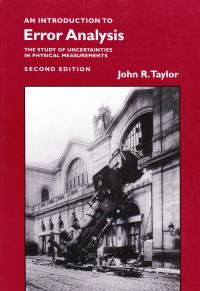An Introduction to Error Analysis, 2nd Edition
An Introduction to Error Analysis, 2nd Edition
By: John R. Taylor
The new second edition of this bestselling text introduces lower division science students to the study of uncertainties in science. This book has been translated into nine languages and has more adoptions than we can count.
For all sales outside of the United States, please contact Felicity Henson, fhenson@aip.org
Title information
This best-selling text by John Taylor, now released in its second edition, introduces the study of uncertainties to lower division science students. Assuming no prior knowledge, the author introduces error analysis through the use of familiar examples ranging from carpentry to well-known historic experiments. Pertinent worked examples, simple exercises throughout the text, and numerous chapter-ending problems combine to make the book ideal for use in physics, chemistry and engineering lab courses. This book has been translated into nine languages, and has more adoptions than we can count.
Translated into Spanish, French, Italian, Japanese, Polish, Chinese, Portuguese, Thai and Korean
Preface to Second Edition
Preface to First Edition
1. Preliminary Description of Error Analysis
2. How to Report and Use Uncertainties
3. Propagation of Uncertainties
4. Statistical Analysis of Random Uncertainties
5. The Normal Distribution
6. Rejection of Data
7. Weighted Averages
8. Least-Squares Fitting
9. Covariance and Correlation
10. The Binomial Distribution
11. The Poisson Distribution
12. The Chi-Squared Test for a Distribution
|
“This text provides a rational, step-by-step introduction to understanding and estimating random uncertainties in physical measurements. Although the text is intended primarily for undergraduate students, I find it useful as well at the research level, to introduce graduate students to unfamiliar topics in the study of experimental uncertainties…a high-quality resource [students] can continue to learn from, even after they graduate.” “Score a hit! The book reveals the exceptional skill of the author as lecturer and teacher. A valuable reference work for any student (or instructor) in the sciences and engineering.” |
John R. Taylor
John R. Taylor is Emeritus Professor of Physics and Presidential Teaching Scholar at the University of Colorado at Boulder. He received his B.A. in mathematics from Cambridge University and his Ph.D. in physics from the University of California at Berkeley. In 1966, he joined the faculty at Colorado, where his research interests include quantum scattering theory and the foundations of quantum theory. Professor Taylor has won numerous teaching awards, served as Associate Editor of the American Journal of Physics, received an Emmy Award for his television series called “Physics 4 Fun,” and given “Mr. Wizard” lectures to some 40,000 school children throughout Colorado. He has written three internationally best-selling textbooks, including the landmark Classical Mechanics, Introduction to Error Analysis, and Modern Physics for Scientists and Engineers.

